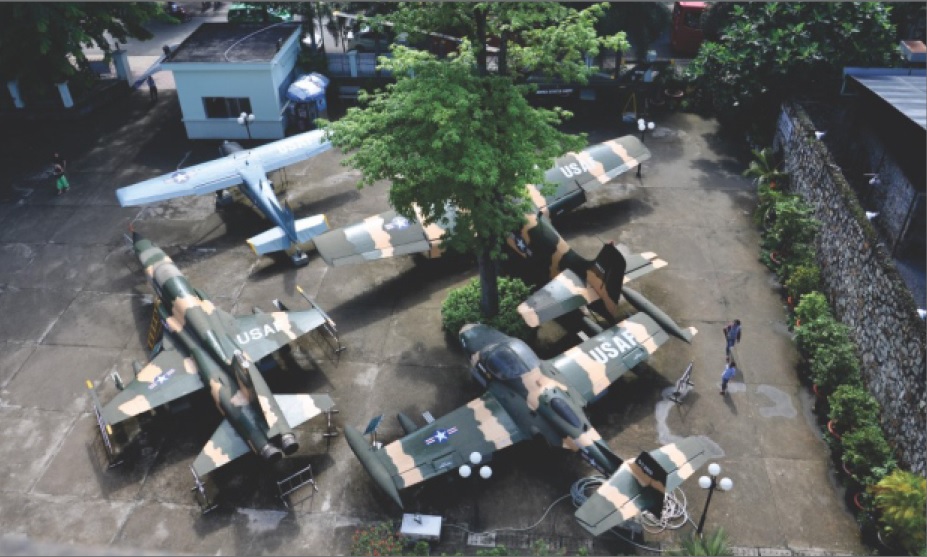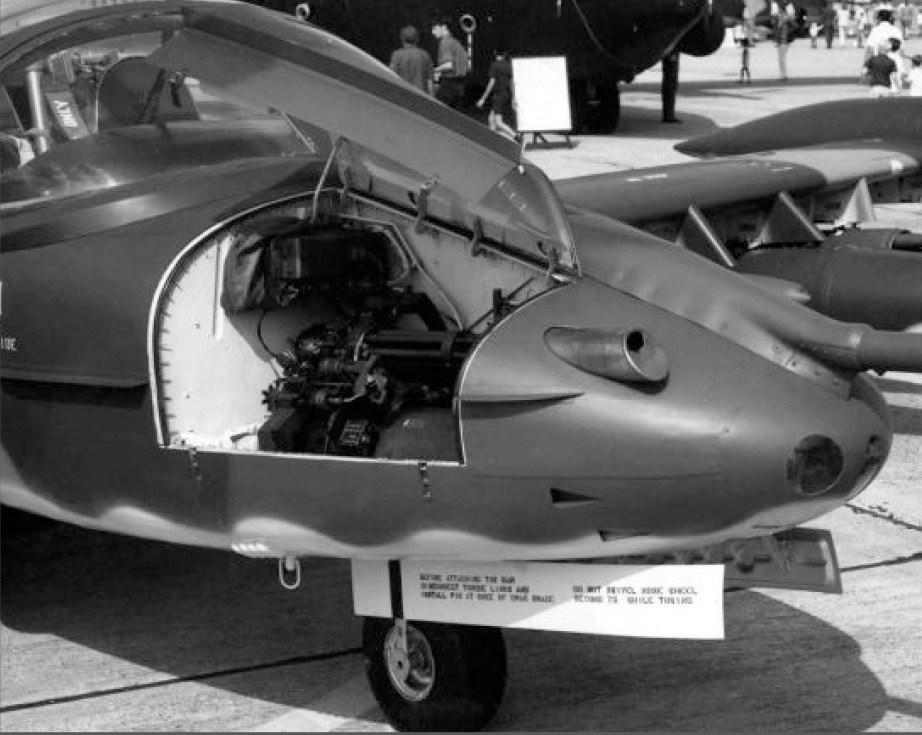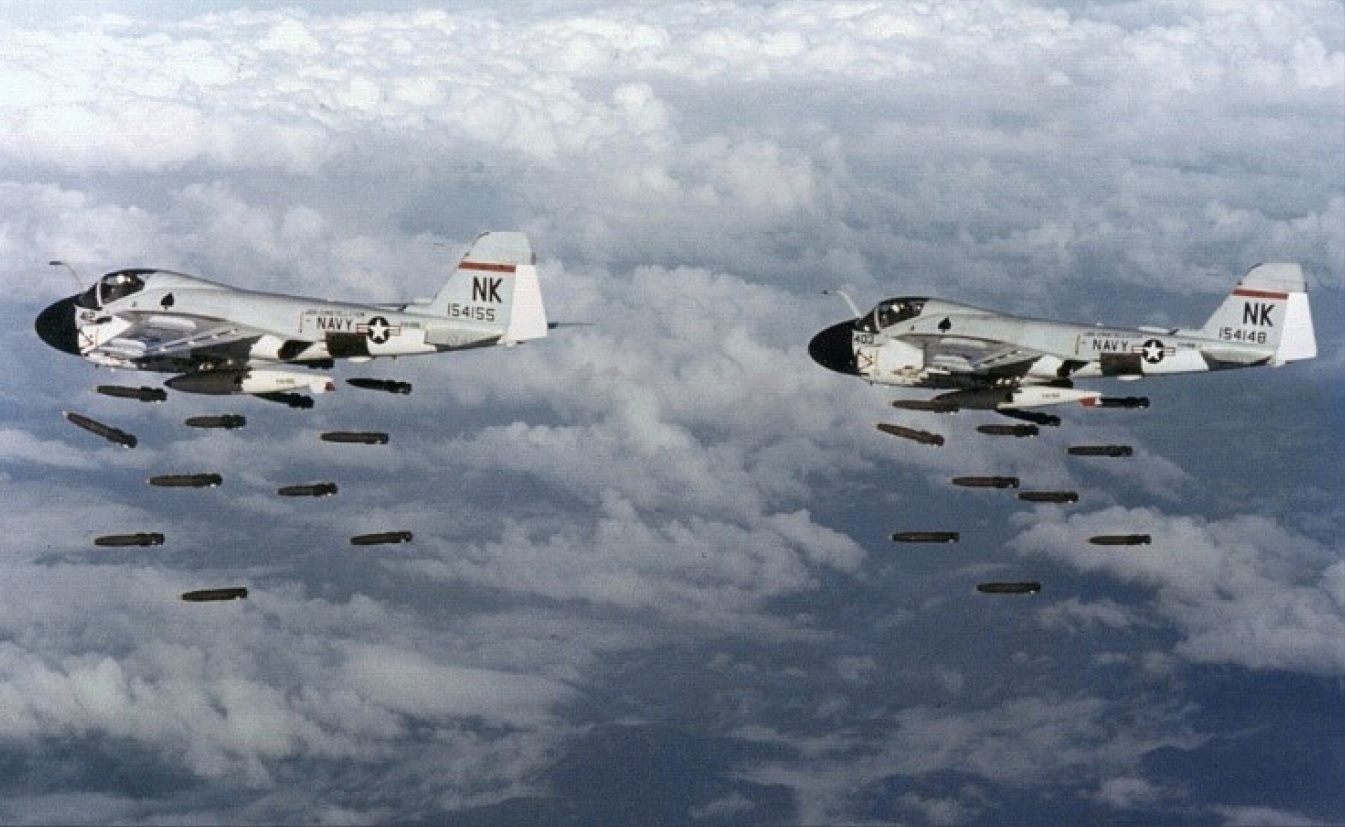The Vietnam War was a war of the United States military in which the role of aircraft was first enhanced and used on a very large scale. Air operations are expanded by the US military, including fighters, attack aircraft, reconnaissance aircraft, bombers, observation and service aircraft, surveillance, patrol, and anti-aircraft aircraft. submarines, aircraft boarding, refueling, transportation.
Based on the nature and mission, combat aircraft of the US military are divided into 2 types:
1. Combat Aircraft: (Fighter)
Interceptor fighters (fighters) such as: E-86D, E-89, F-100A, F-102, F-104, F-106, F-4, F-8, F-14, .. .with the main combat mission in the air, and can also hit targets on the ground when necessary with rockets, missiles or bombs.
Representative:
The F-4 Fanfom is an all-weather long-range fighter-bomber originally designed by MeDonnell Douglas for the United States Navy. F-4's crew consists of 2 people, the maximum speed is 2,340km/h, the highest ceiling is 21,000m with a speed of 9,120m/min, an operating radius of 1,297km (actually about 800km), F-4 It is also equipped with 2-4 Sparrow III air-to-air missiles, 2-4 Sidewinder air-to-air missiles, 2 Shrike air-to-surface missiles, a conventional bomb carrying capacity of about 3,000 kg, and fire control systems. force, radar, jammer modern. With high combat features, F-4 becomes a multi-mission aircraft, both as a fighter, interceptor, escort of B-52s against MIG aircraft, while also performing the mission of attack aircraft, ground support bombers.

After the Gulf of Tonkin incident in 1964, 13 of the 31 squadrons of the US Navy were equipped with F-4 aircraft with different versions as F-4B, F-4J, F-4N. On August 5, 1964, the first time F-4B aircraft took off from the aircraft carrier Constellation to fight in the Vietnam battlefield. In Operation Linebacker II, bombarding the North in 1972, the US military mobilized all 267 F-4 aircraft to fight. During the war, the US Navy's F-4 participated in 84 different operations, losing 445 aircraft, including 193 in North Vietnam.
The F8 Crusader is a supersonic, ship-based fighter that has undergone many conversions, the first F-SA to enter service with the United States Navy in 1957. F-8's pilot consists of one person, has an average speed of 750-850km/h, the longest flight range is about 2,000km, the actual operating radius is about 400km, is equipped with four 20mm cannons, 38 of 70mm rockets, bombs, cluster bombs, 2-4 air-to-air and air-to-ground missiles, weapons control systems, radar, jammers.

In the Vietnam battlefield, the US military mainly used the F-8D, F-8E, and RF-8A. The US Navy used F-8D since 1961, this aircraft is not equipped with an auxiliary oil tank, fitted with J57-P-20 engines under the wings and fuselage with bomb mounts. Similarly, the F-SE is equipped with an auxiliary oil tank under the wings, in service with the navy since 1962. The RF-8A is a photographic reconnaissance aircraft, improved from the F-8A, often operating with the F-8A. to form an armed reconnaissance team. The altitude when scouting is usually 1,000 - 2,500m. The main task of the RE-8A is medium and low-range photography, and can also take pictures at night, equipped with 40 flares contained in 2 launchers mounted on either side of the fuselage. In August 1965, the F-8 aircraft was put into service in the war of sabotage in North Vietnam. At the time, this was the best fighter the United States could use against the North Vietnamese Army's MIG aircraft. However, the F-8 only operated until 1968, ending its mission in Vietnam.
2. Tatical fighter aircraft (ground - attack aircraft):
A tactical fighter (attack aircraft) that is specializes in attacking small, mobile targets on the ground, and at the same time supporting ground forces in operations. Although the speed is not high, the tactical aircraft can fly for a long time, carrying anti-tank cluster bombs, anti-armor and motor vehicles, artillery systems, machine guns and rockets.
Attack aircraft of the air force and navy such as: A-IH, A-7A with the main task of destroying targets on the ground, and can also fight and intercept in the air. Attack aircraft of the United States Navy and Marine Corps are often deployed on attack aircraft carriers or land airfields. Based on features, it is divided into 2 types: heavy attack aircraft like the A-3B, which is essentially equivalent to a light bomber of the air force; Light tactical aircraft such as A-4, A-7 specializes in bombing and bombarding targets at sea and on the ground, in addition to being able to do other tasks such as ground reconnaissance, patrolling. . .
During the war in Vietnam, the US military has put into use modern combat aircraft such as aircraft, A-1 Skyraider, A-4E Skyhawk, A-6 Intruder, A-37 Dragonfly
Representative:
The A-37 Dragonfly is a light jet fighter aircraft, ordered by the United States Army Cessna, modified from the T-37 trainer for the purpose of creating a low-cost light bomber aircraft. In order to meet the needs of "the United States Air Force in the support of infantry operations during the Vietnam War”, the light bomber program was launched by Cessna in 1966 with the prototype of the Yat-37D. On August 1967, 25 prototypes of the A-37 were delivered to Bien Hoa airfield, South Vietnam under the name "Dragon Combat" to conduct field tests including operations. air support, night reconnaissance, airspace control over South Vietnam and Laos. During this time, the A-37 was officially named “Dragonfly — Dragonfly” aka Super Tweet. On the Vietnam battlefield, since 1968, 127 A-37 aircraft have fought with the A-37B version, mainly supplied to the army of the Republic of Vietnam, replacing A-I Skystoners. The main mission of the A-37B aircraft is to support infantry in sweeps, escort transport aircraft and supply and reconnaissance convoys.

A-37 Dragonfly aircraft on display at the War Remnants Museum

The M-134 7.62mm 6-barreled minigun is mounted in the nose cavity of the A-37B. Source: defensemedianetwork.com

An A-37B flies out of Da Nang Air Base, South Vietnam. Source: defensemedianetwork.com
The aircraft A-37B has a length of 8.8m with a total weight of 5,436kg, designed to place 2 fuel tanks with a capacity of 360 liters / barrel. Two General Electric J-85-GE-5 engines are equipped to enhance flight endurance, and can be refueled in the air. The aircraft is equipped with a 6-barreled M-134 7.62mm gun in the nose cavity, a target-to-ground targeting system with rockets, under-wing bomb racks such as Napalm bombs; Mk 40 FFAR surface-to-surface missile and AIM-9 Sidewinde-to-air missile, with a total weight of 2,130 kg. A-37B has a slow speed, an average speed of about 450-550km/h, but relatively strong firepower, allowing accurate bombing of targets. At the same time, the A-37B is also equipped with a long-range communication system to ensure operational command and coordination with ground forces.
A-6 Intruder : The A-6 Intruder, built by Grumman Aeronspace, is a ship-based attack aircraft that replaces the Douglas A-I Skyraider, for service with the United States Navy and Marine Corps.
The A-6 Intruder was put into the Vietnam battlefield from February 1963 and participated in the US Army's Linerbacker I, II bombing campaign to destroy the North. The longest flight range was about 4,600km, the average speed was about 720km/h, the total weight was about 19,422kg and could operate in all weather conditions, making it the most efficient aircraft at that time. The A-6 is equipped to carry and launch nuclear weapons, 2 Bullpup air-to-surface missiles, 2-4 Shrike air-to-surface missiles, 2-4 Sidewinder air-to-air missiles, 70mm and 127mm rockets, can carrying a maximum of about 6,800 kg of bombs (actually carrying about 3,000 kg of bombs). A-6 is a low-altitude attack aircraft, so the semi-automatic bombing method has been researched, developed and equipped by the US military (Low Altitude Bombing System — Initial Point LABS-IP). However, low flying and bombing made the A-6 vulnerable to anti-aircraft fire, and in eight years of service, the US Navy and Marine Corps lost 84 Intruders.
The A-6 features sophisticated avionics, a high degree of integration with DIANE autopilot, AMN/APQ-92 collision room radar, AN/ground target detection and search radar. APQ-88, reconnaissance receiver AN/APR-23, AN/APR-27, radar jammer AN/ALQ-41, AN/ALQ-51. Therefore, A-6 is often used to fly low at night or in bad weather to hit targets on the ground and water. (to be continued).
 '
'
Two US Navy A-64 Intruders from Attack Squadron 196 (VA-196) dropped Mk 82 227kg (500 lbs) bombs over North Vietnam during Operation Rolling Thunder, 1968. Source: Printerest